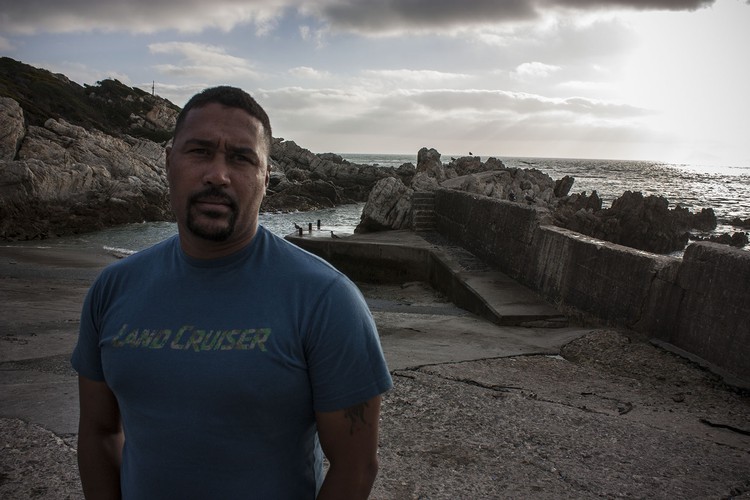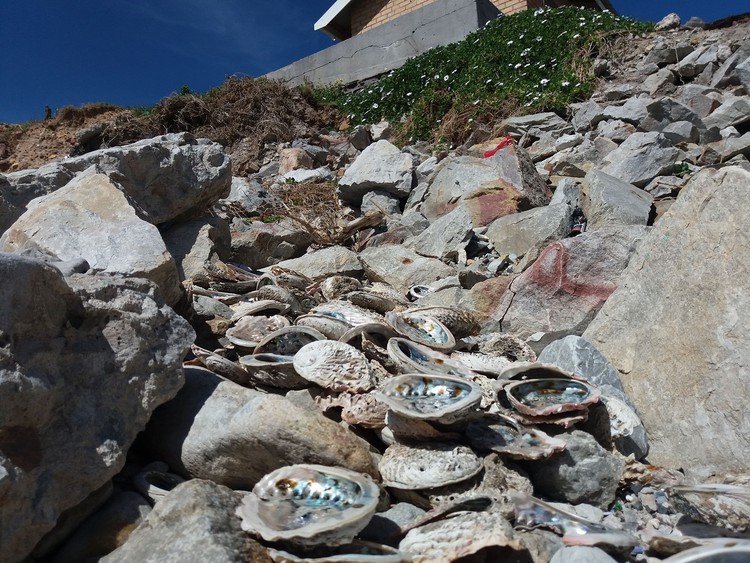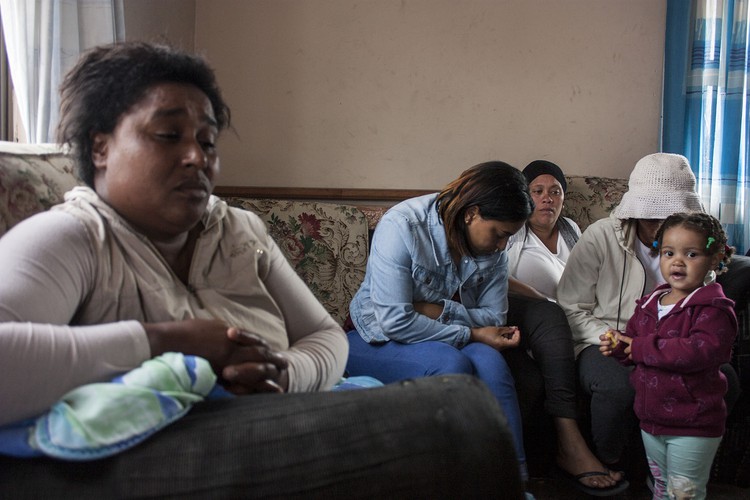
Commercial nearshore fisherman Sherman Pharos echoes the sentiments of many in the Hawston community who believe reducing the Total Allowable Catch for crayfish and abalone merely turns fishers into poachers. Photo: Steve Kretzmann/WCN
20 September 2017
On weekends when the sun is shining and the wind isn’t gale force, the natural amphitheatre of rocks surrounding the Hawston harbour slipway is filled with locals quenching their thirst with beer, braaiing fish and sharing jokes.
That was the scene this past Sunday afternoon, with youngsters fishing from the breakwater and the occasional small vessel providing entertainment as it came in, timing the surge of the waves to berth on the waiting trailer.
As the calm spring day waned, two young men in scuba gear emerged from the water. But rather than offloading their air tanks and peeling off their wetsuits to join the revelry, they kept checking the time. Their friend, Waylon Love, was still in the ocean. As the seconds ticked by it became increasingly apparent that he’d been in too long. The reserves of air in his tanks did not match the time he’d been diving. At 5:49pm, the alarm was raised.
The National Sea Rescue Institute (NSRI) arrived and launched a boat. On board was Love’s fellow diver, Deegan Windvogel, who descended back in the water and tried to find his friend, to no avail.
Twenty minutes later, the NSRI were called away to nearby Kleinmond where they helped rescue a 29-year-old man caught in a riptide. There was little hope for Love, whose body was found by some local boys, washed up on the rocks on Monday morning.

Growing up in the poor but proud fishing community of Hawston, just a ten-minute drive from upmarket Hermanus, the only hope 25-year-old Love had of providing for his widowed mother and 19-year-old brother, was to try and make a living from the sea. But people of Hawston don’t blame the sea for his death. They hold the inequity of the Department of Agriculture, Forestry and Fisheries (DAFF) fishing allocation and quota system, and a government that fails to provide proper facilities for poor people, responsible for the events that led to his death.
Seated on an old worn couch in a sparsely furnished room in which the electrical sockets still wait for wiring, Sharolene Love, 42, sat surrounded by friends doing their best to comfort and care for a mother in grief. Outside, sitting in a fishing boat parked in the yard, Love’s friends and peers smoked and quietly shared their communal loss.
Inside, Sharolene told how her son and his friends were teaching themselves how to scuba dive. They had tried to dive in the municipal pool, but that was locked up as, unlike in wealthier neighbourhoods where the pools open on 1 September, the Hawston pool only opens on 1 December. The young men were hoping to find someone to open up for them and let them practice, but were unsuccessful. They then snorkeled in the vlei but visibility was too poor, and so, unbeknown to the man who was offering informal instruction, they went into the ocean. In a typical fishing community, fishing and diving equipment are handed down, passed on, borrowed and found.
Unlike middle class families who are able to take professional diving lessons, Love wasn’t trying to learn to dive for fun. He was trying to learn a skill that would help him provide for his family: diving for abalone. He would have been able to sell his catch for about R300 a kilogram on the black market, although the end user in China would pay up to R4,500 per kilogram, according to SANParks.
With no formal qualifications, a soaring unemployment rate, no capital and little to no hope of successfully applying for a commercial permit, poaching was one of the only practical options Love could see to supplement his mother’s earnings as a char. And in order to do so, he needed to teach himself how to dive.
It’s not the first and it won’t be the last time this happens, said Sherman Pharos, a commercial nearshore diver and fisherman who started out poaching abalone as a teenager in the late 1990s in order to provide for his 12-year-old brother.
Pharos was born in Hawston but the family moved to Johannesburg when he was a child. He eventually ended up living on the streets after his mom died and his dad hit the bottle. It was his little brother, who had been sent to live with his aunt in Hawston, who drew him back to his birthplace. There, the search for a living led to him becoming a bagman for abalone poachers (carrying the heavy bags of harvested abalone across kilometres of rough country to a remote road for pick-up) and eventually diving into the ocean himself.
But being a poacher was a necessity, not a desire. So when the state announced the availability of permits and quotas for abalone and West Coast Rock Lobster (crayfish) in 1999, Pharos obtained his commercial diving license and sent in his application. He was one of the lucky ones, receiving a quota allowing him to become a legal fisher.
Pharos says in the late 1990s the abalone quota was between 13 to 16 tons per diver, a tonnage that he used to set himself up with a boat, a house, and establish a family of his own. Then in 2004, he says, the quota was drastically reduced to between 400 and 600kg per diver, and further reduced to 223kg per diver in 2014.
The equally lucrative crayfish quotas have been reduced from 750kg to a measly 304 kg over the same period, he says.
With only 2.5% of pre-fishing level stocks of West Coast rock lobster left, and abalone stocks down to 15% according the stock assessment conducted last year, WWF-SA marine programme senior manager John Duncan believes the Total Allowable Catch (TAC) determined by DAFF for crayfish, from which quotas are then allocated to commercial offshore, commercial nearshore, and small-scale fishers, needs to be reduced by a further 59% in order to ensure stocks can start returning to healthier levels.
This proposal was put to fishers on Tuesday 5 September, which sparked violent protests in Hout Bay’s Hangberg fishing community last week.
But Duncan said crayfish populations were in danger of collapsing and the scientific team had “tried very hard” to set recovery targets and reduce the TAC in the past, but these targets had largely been ignored by the minister.
He said if the estimated 1,500 tons of crayfish poached along the west coast per year could be curbed, the TAC for crayfish, which was 1,925 tons last season, could be increased, or at least maintained.
According to FEIKE natural resource management advisors, the 95 ton TAC for abalone is dwarfed by a poaching industry that takes out about 3,000 tons a year.
But for fishing communities that have lived off the sea for generations and know no other way of life, clamping down on poaching simply takes food out of families’ mouths. “Everyone wants to be legal,” says Pharos. “It’s DAFF that turns them into poachers.”
Rather than reducing the TAC and clamping down on poaching, he believes DAFF should take the quotas handed out to big commercial offshore companies such as Oceana, Lusitania, Viking and Sekunjalo, who were allocated 963 tons of crayfish between them last season, and pass them on to commercial nearshore operators and small-scale fishers.

FEIKE, on its website, also argues that with abalone poaching outstripping the legal allowable catch by over 40-fold, DAFF should “increase the legal limits substantially to encourage greater levels of compliance by current right holders and to displace illegal fishing”.
While the large commercial offshore fishing companies would undoubtedly lobby hard to retain their quotas, Pharos argues that they can retain their profitable processing operations and let their quotas be handed to commercial nearshore operators embedded in fishing communities, and small-scale fishers, who sell their catch to them anyway. In fact, providing the bulk of the TAC to commercial offshore operators’ who also own the processing, cold storage and distribution, and marketing and sales, hands them the power to manipulate the price they pay to small operators such as himself, he argues.
Pharos explains that the crayfish season runs from November to July, but most nearshore operators would have caught their quotas within the first few weeks of the season. By the time the season opens again, the nearshore quota holders have had little to no income for months. So when they take their first catch of the season to the factory owned by one of the commercial offshore operators, they offer a low price of R250/kg payable upfront. The nearshore and small-scale fishers can take a market price, but that takes up to 12 weeks to be paid.
“When you haven’t had money for months and you have to pay for your children’s school fees and fix your boat motor and everything else, it’s very hard to say no to money upfront,” says Pharos.
Additionally, he says fishers apply to DAFF for an export permit through the factory they sell to, but these are often only issued to them by DAFF in January, two months into the season. As a result the export price often would have dropped from an early high of about US$55/kg (approx R700/kg) which the offshore operators cash in on, to as low as $22/kg (approx R280/kg). Furthermore, he says the offshore operators don’t bring in their full quota by the close of the season in July, and apply for an extension to September. During this tail-off period, the export price climbs back to $50 levels as the product becomes scarcer, allowing them to rake in more profits while the nearshore operators finished their quotas long before the season came to an end. “And then even after the extension, they still undercatch on their quotas by 40 or 50 tons. It happens every year,” he says.
Shifting crayfish quotas from offshore operators to nearshore and small-scale fishers could significantly increase the money circulating in traditional fishing communities and bring poachers into the legal industry. For while nearshore operators such as Pharos might earn a gross of about R250,000 to R350,000 from their quotas of about 300kg crayfish and 200kg abalone, they employ up to five people in the community to help bring in the catch, and have to cover costs such as a catching fees of up to R75/kg, a permit fee of R1,080, bait, levies to DAFF of R20 – R40/kg, petrol, and boat and engine maintenance.
According to results posted on its website, Oceana posted an operating profit of R515 million in the six months to March 2017, with R1.7bn in the 2016 financial year. Yet crayfish comprises less than 2% of its operations.
The loss of that 2% may upset Oceana shareholders but it might go a long way to improving life in fishing communities, gaining the trust necessary to move to more sustainable management of stocks. It may perhaps even prevent more young men such as Waylon dying while trying to obtain the skills they need to feed their families.
Moegsin Ismail, information officer for Masifundise, an organisation dedicated to empowering fishing communities, agrees that cutting the TAC for nearshore operators and small-scale fishers “will amplify hardship within the communities”.
Referring to the proposed 59% cut in the crayfish TAC, he said that Masifundise hoped the department “will really reconsider implementing such drastic cuts”. At the same time, Ismail said the organisation recognised the need to protect stocks, but “if you have to cut, rather cut the big commercial companies”.
If the scientific stock assessments are correct, DAFF has to come up with ways to increase the flow of money into the approximately 300 fishing communities along South Africa’s coastline while preventing the collapse of lucrative crayfish and abalone stocks. Squeezing the nearshore and small scale fishers further is only likely to result in further violent protests as seen in Hout Bay last week, or the 2012 protests in which the entire Hawston community went to war with police after it was suspected police had a hand in the drowning of alleged 19-year-old poacher Steven “Sai” Figaji.
And that the current approach of squeezing the TAC across the board is simply turning fishers into poachers, is a view echoed by many voices in Hawston.
The development of the Small Scale Fisheries policy (SSF) is supposed to offer hope to communities. It was adopted by Cabinet in 2012 after small scale and artisanal fishers approached the Equality Court after being excluded from the long-term fishing policies adopted in 2005. The policy requires fishers to register with proof of long-term involvement in fishing, and then set up co-operatives under which they will operate.
In the meantime, small-scale and artisanal fishers are operating under an interim relief permit, with 705 tons of west coast rock lobster having been allocated to them under interim relief during the last season.
However, Associate Professor Mata Hara, who is deputy director at the Institute for Poverty, Land and Agrarian Studies (PLAAS), says while approximately 7,000 fishers currently operate under interim relief quotas, about 30,000 people qualify under the SSF policy.
While these numbers are for the entire coastline, with west coast rock lobster only available along the west coast and southwestern Cape, Hawston fishers involved in the development of the SSF policy said there are 97 interim relief fishers in Hawston, and over 400 people registered as small scale fishers who are simply waiting for the policy to be implemented. This figure echoes the 1:4 ratio of Hara’s national figures.
When the policy is implemented, unless the TAC is increased or shifted from commercial offshore operators to the small scale fishers, there will be a lot less crayfish and abalone available per person. “The slices of the cake just gets smaller,” says Hara.
In the meantime, with the crayfish season expected to open on 1 October in the Northern Cape and 1 November in the Western Cape, DAFF deputy director general Siphokazi Ndudane says the current 1,925 ton TAC for crayfish is unlikely to be cut, despite scientific recommendations of a 59% reduction.
“We are not a department of fisheries,” she said, “but a department for people who fish.”
So, she says, reducing the TAC will simply punish legal fishers for the depletion of resources as a result of poaching.
Speaking last week, Ndudane said that last season the recommendation was to cut the TAC by 34%, but “we did not go with those recommendations, in order to protect jobs and liveliehoods. We want to keep the TAC where it is and drastically increase law enforcement [to cut down poaching and over-catching].”
She said former MD of Hout Bay Fishing Industries Arnold Bengis was earlier this year ordered by a US court to pay $37m (approx R480m) back to South Africa after being found guilty of over-fishing South African waters for 14 years and exporting his catch to America.
Part of this money would be used to change employment conditions for compliance officers so that officers would be on duty around the clock rather than knocking off at 5pm.
A new mobile app, called Abalobi, was also being introduced so that fishers’ catches could be accurately recorded, replacing the paper system that was inefficient and easily corrupted.
However effective the intended clampdown on poaching, as long as fishers’ families are going hungry Pharos’s predictions that Waylon Love’s death won’t be the last such tragedy fishing communities face, are likely to come true.

The Total Allowable Catch for West Coast Rock Lobster (crayfish) last year: